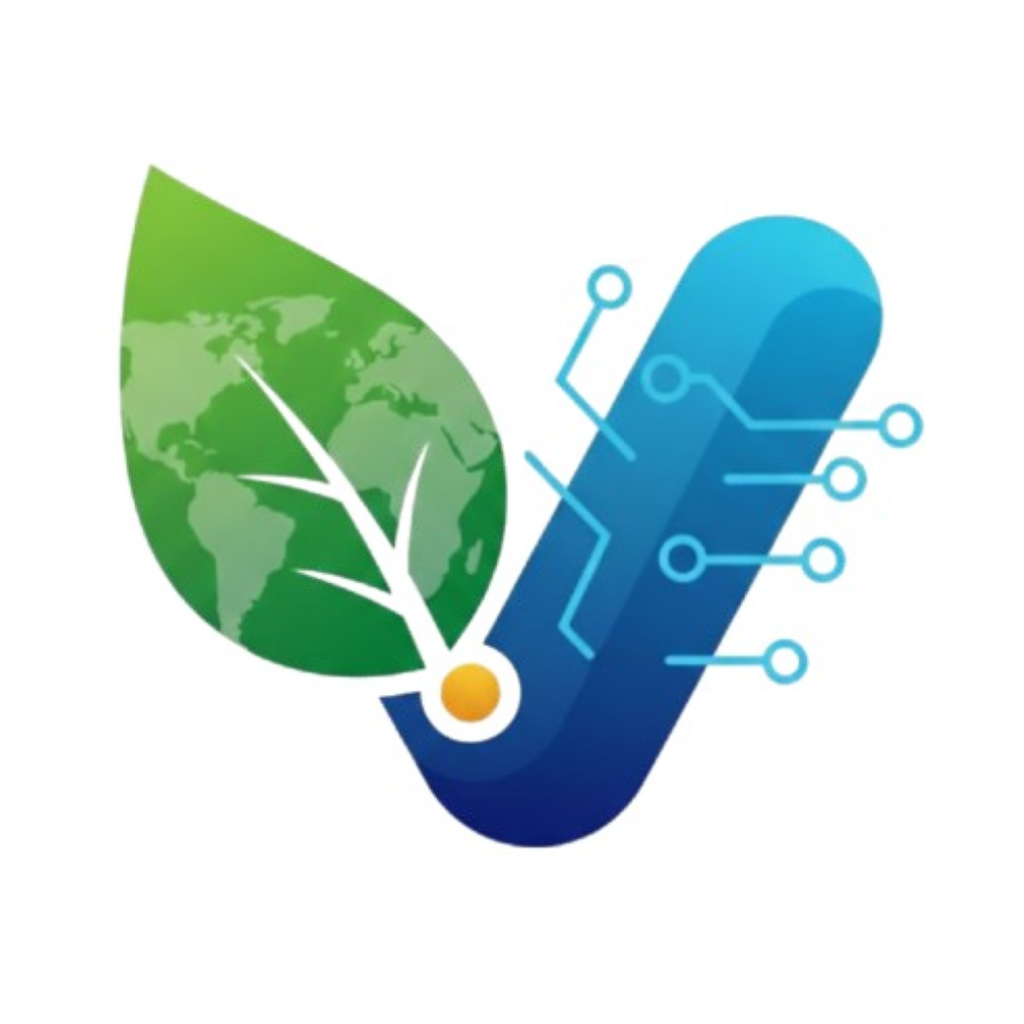
VERDAN
Smart Tech, Safe Harvest, Stronger Communities
While food is essential for survival, it can also become a medium for silent and deadly threats.
Imagine a silent, undetectable explosive device hidden deep in your kitchen that is set to explode over years rather than seconds. Aflatoxin is just that!
The food we depend on the most contains a delayed-action poison. Every meal that contains even a small amount of contamination is like another tick on the countdown clock, putting families at risk for liver cancer, stunted child growth, or even unexpected death.
Furthermore, aflatoxin is not limited to humans. When livestock are fed tainted maize, the toxin seeps into milk, meat, and eggs, which then makes its way back onto our plates. It stealthily spreads poison from farm to family, weakens animals, and reduces yields. Whole populations are affected by something that starts in the soil.
Aflatoxin contamination costs Kenya’s maize economy alone over €1 billion annually, depriving farmers of revenue, driving up food prices, and sabotaging trade. Additionally, chronic health effects, such as immune dysfunction and liver cancer, add €520 million to public health expenses, taxing hospitals and depleting the workforce. A vicious cycle results, with communities being locked in as poverty increases, malnutrition spreads, and investor confidence declines.
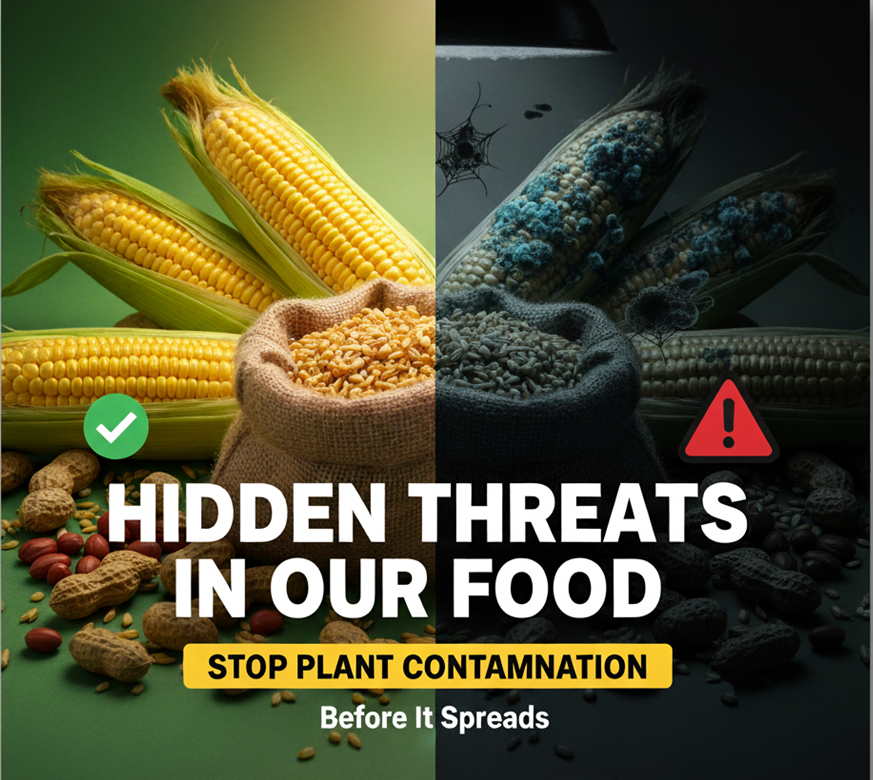
Understanding the Core Problem
Aflatoxins are IARC Group 1 carcinogens—its been demonstrated they cause cancer in humans. Their lack of visibility makes them deadly: even maize that looks normal may be contaminated to the level of lethality. Just one contaminated kernel in 5 pounds of corn could exceed FDA limits. Now consider a railcar, carrying 196,000 pounds— detection using traditional methods is like finding a poisoned needle in a haystack.
This hidden danger cascades across the food system:
- Farmers lack affordable detection tools, facing crop rejection and economic loss.
- Buyers struggle to ensure batch safety, risking supply chains and reputation.
- Governments can’t track hotspots in real time, often reacting too late.
However, this is where the narrative shifts. Despite being a silent killer, aflatoxin is not unbeatable. We can stop this poison before it reaches the plate with Verdan, a low-cost, environmentally friendly, and all-inclusive solution that costs less than a fertilizer packet. For the first time, smallholders, buyers, and governments can defeat this threat on a large scale thanks to validated field tests, predictive AI alerts, and farmer-friendly interventions.
Solution
Verdan is a comprehensive ecosystem designed to detect, prevent, and manage aflatoxin contamination at every level of the maize value chain. It combines an AI-driven aflatoxin detection system, rapid field-level screening, a mobile app for highly accurate, real-time analysis. With multilingual, voice-enabled, and offline-first access, the platform ensures that farmers, buyers, and governments can all participate effectively—no matter their location or connectivity.
1.For Farmers
Free Features –
i. The farmer inputs 4 features using simple guided questions with visual examples: soil health (e.g., dark and crumbly = Excellent, hard and cracked = Poor), pest status, fertilization status, and water availability. These are rated as Excellent, Average, or Poor based on clear reference images and descriptions provided in the app. The platform automatically fetches 5 additional features via free satellite and weather APIs—GPS location, NDVI (vegetation health from Sentinel-2 satellite), soil moisture estimates, temperature, and humidity—requiring no additional sensors or equipment from the farmer
ii. The farmer will be connected with the other farmers, through the community feature of the app, to discuss with other farmers about pressing issues they face and collaborate to find solutions to those issues.
iii. The farmer can ask any query related to the app by a voice-assisted AI chatbot.
The premium Features (that costs less than a pack of fertliser) –
i. Access to the latest updates.
ii. Patented ideas that can detect aflatoxin better
iii. One-on-one consultations with agricultural experts for tailored guidance.
iv. Video tutorials on world-class agricultural practices, helping farmers adopt proven, scalable methods.
v. Full integration and support for IoT devices, allowing continuous monitoring and smart decision-making at the farm level.
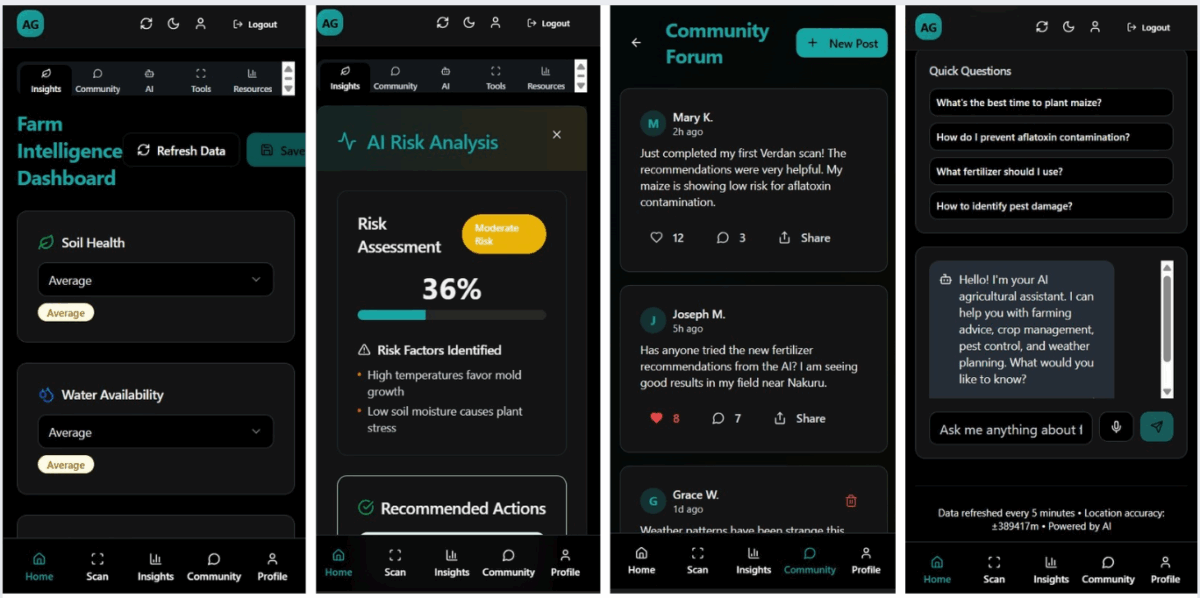
2. For Buyers
Buyers,aggregators and traders are enabled to safeguard supply chains and ensure market confidence;The app allows buyers to input batch-specific parameters during procurement—including storage conditions (dry/damp, ventilated/closed), transport details (duration, vehicle type), ambient humidity, and visual crop quality observations. Buyers can also upload maize images for AI-powered aflatoxin testing. This data is entered manually by the buyer based on their warehouse conditions and transport logs—no real-time sensors are required at this stage, though IoT integration is available for premium users who manage their own storage facilities.
Decision outcomes:
If no aflatoxin is detected → the batch is cleared for the market.
If aflatoxin is detected → the buyer still purchases the batch but redirects it through the platform to us. We then channel the contaminated maize to ethanol-producing industries, where it becomes a cheap, efficient raw material. This approach prevents waste, sustains farmer incomes, and strengthens the circular economy by converting risk into opportunity.
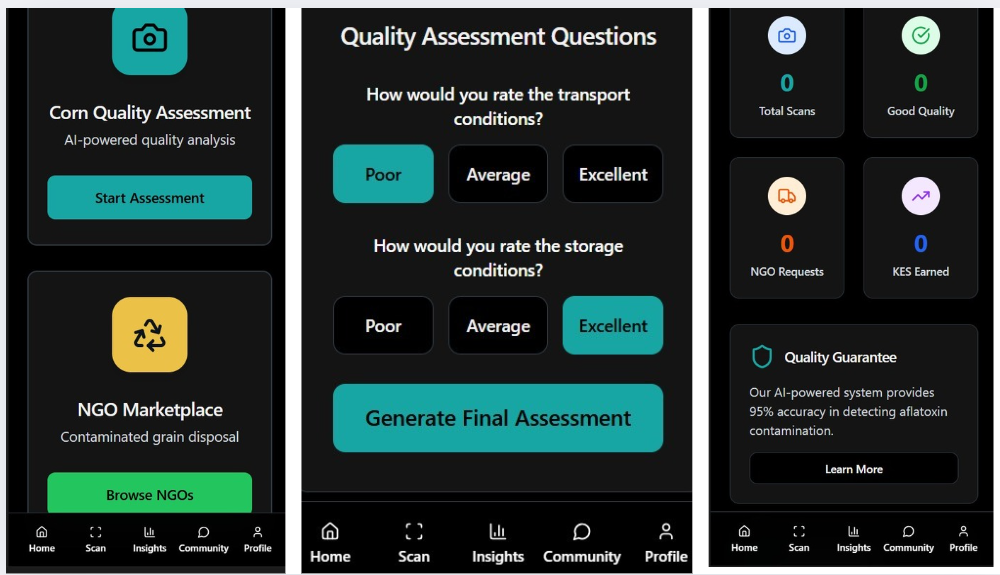
3. For Government Officials
Governments and policymakers gain access to a data-rich decision support system to strengthen national food safety and public health initiatives.
Traceability Dashboard: Provides location-wise contamination data, visualized through maps, charts, and reports to simplify decision-making and resource allocation.
Predictive Alerts: Powered by AI, the system generates real-time outbreak warnings, enabling governments to respond proactively before aflatoxin spreads at scale.
These insights equip authorities to design better interventions, optimize food safety budgets, and build long-term resilience in food systems.

Awareness & Community Education
Technology alone will not eliminate aflatoxin; awareness is part of the solution. Much of the problem lies in the fact that aflatoxin is invisible, underestimated and poorly understood by both farmers and consumers. In order to address this, we established a YouTube channel to raise awareness of aflatoxin risk, safe agricultural practices, and the advantages of using tools such as Verdan.
By producing easy-to-understand, multilanguage videos, we put knowledge back in the hands of the communities, because prevention starts with awareness. Farmers will learn how to protect their harvest, buyers will learn how to source safely, and consumers will advocate for food safety initiatives. This layer of awareness complements the platform, to ensure that our fight against aflatoxin is a cultural and educational one, as well as a technological one.
Why Verdan Works
Verdan connects farmers, buyers, and governments, addressing aflatoxin at critical stages from soil health, through pre and post-harvest risk alerts, batch-level screening, sustainable reuse, and outbreak prevention at a national level.
Verdan is cheap, sustainable, and inclusive; it costs less than a packet of fertilizer, but delivers peace of mind, market confidence, and systemic protection against one of agriculture’s most dangerous, hidden threats.
USPs of the solution
1. Fixes the farmers practices in preflowering stage by suggesting methods that would reduce aflatoxin growth
2. Addresses both concerns of preflowering stage detection and post harvest detection
3. Platform designed to serve multiple stakeholders-farmers,buyers and government officials
4. Voice first design
5. Offline Mode is available
6. Smart voice based chatbot to assist farmers
7. Gamified interface to increase app usage
Sustainable Business Model
Sustainability is no longer optional—it is the foundation of resilient businesses in the modern world. Our model not only addresses aflatoxin contamination but also aligns with global priorities such as reducing carbon footprints, supporting green value chains, and strengthening food security. By integrating farmers, buyers, and governments into a single ecosystem, the Verdan Platform creates long-term impact and economic sustainability.
Key Partners
- Government institutions: Ministry of Agriculture (MoA), Kenya, Kenya Plant Health Inspectorate Service (KEPHIS).
- NGOs and cooperatives working directly with smallholder farmers.
- Agro-dealers, commercial buyers, and trade associations.
- Farmers themselves, as both beneficiaries and contributors of real-world data.
Key Resources
- Verified farmer networks and trusted extension partners.
- Labelled sample bank & calibration lab agreements for model accuracy.
- Scalable cloud infrastructure.
- Core engineering and operations team for continuous improvement.
Key Activities
- Development, retraining, and deployment of AI models.
- Field operations for sample collection, testing, and validation.
- B2B sales and partnership building with buyers and county governments.
Value Propositions
- For Farmers: Early risk alerts and AI-driven soil guidance, reducing losses and improving productivity.
- For Buyers: Batch-level aflatoxin screening for safe, verifiable sourcing.
- For Governments: Real-time contamination data and predictive outbreak detection for timely interventions.
Customer Segments
- Farmers → Primary users of risk prediction tools, chatbot services, and expert guidance.
- Buyers/Traders → Pay for verified maize sourcing and safe supply chains.
- Government Officials → Use dashboards and predictive models for interventions and hotspot detection.
Customer Relationships
We focus on building long-term trust with all stakeholders by delivering measurable reductions in aflatoxin contamination, consistent support, and continuous technological improvements.
Revenue Streams
- Buyer subscriptions (tiered by scale of operations).
- Analytics contracts with county and national governments.
- Premium farmer services (consultations, IoT device support, market linkage fees).
- Affiliate revenues and verification fees for bad-crop collection logistics (linked to ethanol industry).
Channels
- NGO partnerships for community outreach.
- Government contracts and county-level pilots.
- Agro-dealers as local distribution hubs.
- Buyer integrators (mills, exporters) and trade associations.
Cost Structure
- Model retraining and validation using user data.
- Cloud infrastructure and technical operations.
- Sales, partnerships, and outreach programs.
- Field distribution and local capacity building.
Market Sizing (Conservative Estimates)
- TAM (Total Addressable Market): ~3.0M+ smallholder maize farmers in Kenya.
- SAM (Serviceable Available Market): ~1.2M farmers in high-risk aflatoxin regions with strong maize markets.
- SOM (Serviceable Obtainable Market, 5-year target): 150k–200k farmers (10–15% of SAM) actively using the platform.
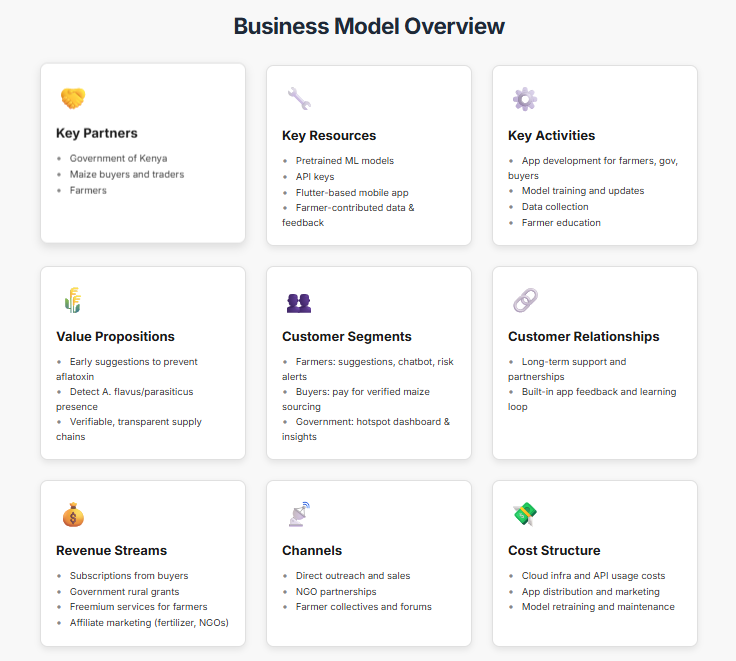
Market Survey
Following is a comarison table that compares the Verdan Plartform with other existing solutions.
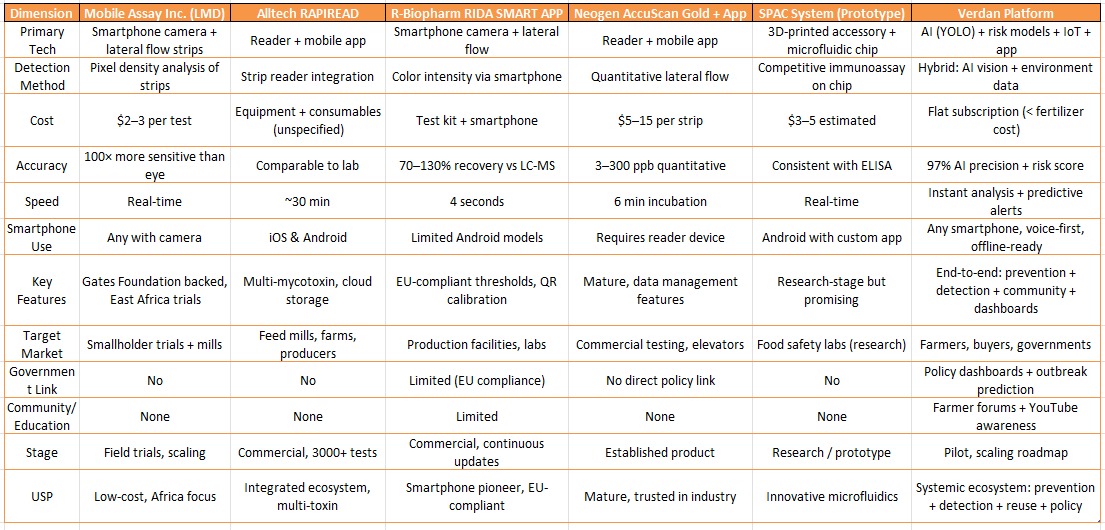
Go To Market Stratergy
Phase 0 — Pilot (Months 1–12)
We start with 50–100 farmers in one village. Partner with a local NGO and extension officers who farmers already trust. Spend this time gathering feedback daily, fixing bugs, and proving the model works with real ground-truth samples.
Months 7–12: Scale to 500–1,000 farmers across 2–3 villages. Introduce premium subscriptions to ~15% of active users.
Target: 60% retention at Month 12, first paying customers, one county government interested.
Phase 1 — Regional Rollout (Years 2–3)
Expand to 3–4 nearby counties, targeting 8,000–12,000 farmers. We’ll partner with NGOs, agro-dealers, and cooperatives who already serve these regions. Secure our first 1–2 county government contracts for the dashboard.
How we acquire users: Extension officer trainings, demo days at agro-dealers, radio spots in local languages, farmer referral bonuses.
Target: 10,000 active farmers, 2000–3000 buyer subscriptions, operational sustainability.
Phase 2 — National Scale (Years 4–5)
Roll out to 5–8 counties through Ministry of Agriculture partnerships and integrate with major millers and exporters. Reach 80,000–120,000 farmers.
Target: Establish Verdan as a trusted aflatoxin management solution across East Africa.
Pricing and Affordablity
When we say “costs less than a packet of fertilizer,” we mean it. In Kenya, a standard 50kg bag of DAP fertilizer costs approximately KES 3,500–4,500 (~$27–35 USD). Our pricing is designed to be a fraction of that:
For Farmers:
- Free tier: Completely free access to risk prediction, community features, and AI chatbot.
- Premium tier: KES 500–800 (~$4–6 USD) per growing season for expert consultations, video tutorials, and IoT device integration.
For Governments:
- Custom contracts based on data needs, typically $5,000–20,000 annually per county.
How we keep costs low:
- Progressive Web App (PWA) architecture eliminates app store fees and reduces development costs.
- Free satellite and weather APIs (Sentinel-2, OpenWeather) mean no sensor deployment expenses.
- Cloud-based infrastructure scales efficiently with user growth.
- Partnerships with NGOs and extension services reduce distribution and training costs.
- Contaminated maize redirection to ethanol industries creates a revenue stream that subsidizes farmer-facing costs.
Technical Details
The Verdan Platform utilizes a scalable, and farmer-friendly technology stack that allows for real-time accurate results while working in low-connectivity environments.
Core tech stack
React — Used to build a Progressive Web App (PWA) that works seamlessly on smartphones as well as desktops, ensuring accessibility across devices.
PyTorch — Framework for developing and training the machine learning models that power aflatoxin detection.
YOLO (You Only Look Once) — Finetuned for image classification to distinguish between healthy and contaminated maize.
Docker — Ensures scalability and smooth deployment across different environments.
Vercel — Hosting platform for the frontend, enabling fast and reliable performance.
Supabase — Provides secure storage and management of farmer, buyer, and testing data.

How does the analysis of aflatoxin work?
Most of the aflatoxin outbreaks happen in the preflowering stage due to unsustainable practices by the farmer. Verdan platform helps them just by answering 4 qualitative questions about the farmer’s field, the farmer can get tips and suggestions on how to improve his/her field.
These tips and suggestions are not random and vague instead they are clear suggestions delivered based on an extensive training of Machine Learning based model.
How does the image classification model work?
The model is trained on various images of corn containing aflatoxin and healthy corn. The YOLO(You Only Look Once) is finetuned and trained in such a way that it can understand patterns that make up for the defective corn and the ones that are present in a healthy corn cob. Many times these patterns are not visible to the naked eye so this eliminates guesswork.
The YOLO image classification model is most effective post-harvest, when fungal growth and toxin accumulation have progressed enough to show visual indicators (discoloration, mold, kernel damage). Early-stage contamination during pre-flowering is invisible to imaging, which is why our 9-parameter risk prediction system is critical for prevention before harvest. The image model serves as a verification tool for buyers and a safety net for post-harvest batches.

The model performed well got a precision and recall of 97%. The results are displayed below:
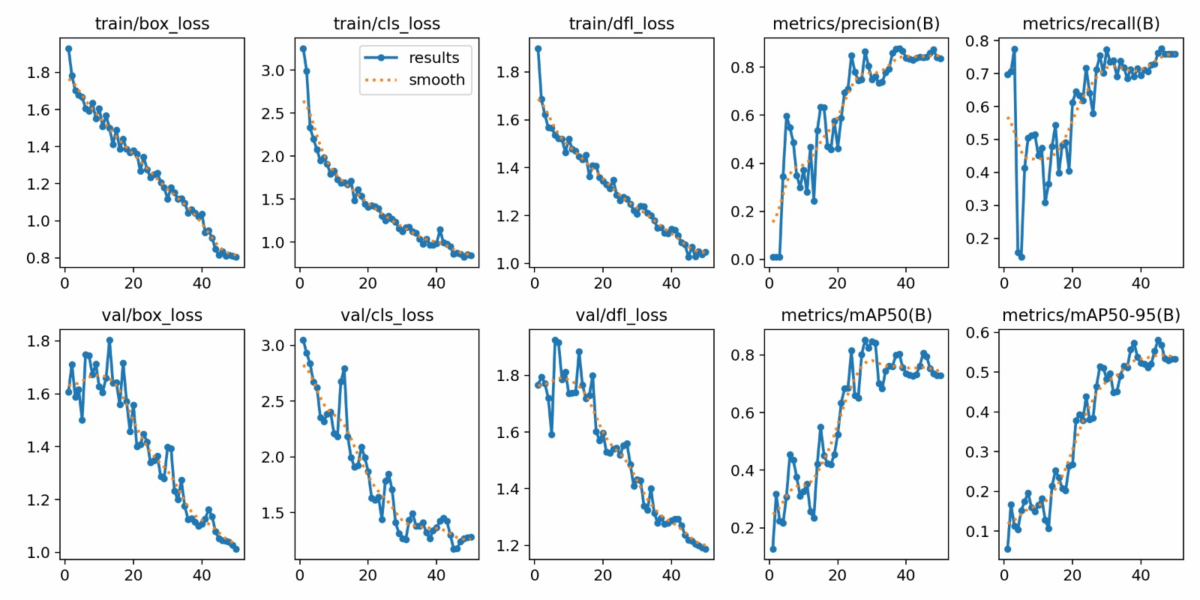
However prediction only based on the deep learning model is’nt always the correct one so the final prediction is made by combining the storage,transport and Deep Learning model result which are primary factors of aflatoxin in post flowering stage. Based on all of these factors a risk assessment score is produced which is given by:
Risk Assessment=(0.33*YOLO Model Prediction)+(0.33*Storage Conditions)+(0.33*Transport Conditions)
This score is normalised from 1-100 making the final risk assessment score.
How does the offline mode work in real time?
The data is synced real time when the network is present, for the time being the APIs call the last fetched data and use that as the input to train the model
Field Visit
During our journey toward building the Verdan Platform, we had the incredible opportunity to visit Punjab Rao Deshmukh College, Nagpur, and Agriculture College, Nagpur—two leading institutions in agricultural research and education. These visits were crucial in deepening our understanding of the real-world challenges faced by smallholder farmers.
We explored several key sections of the colleges:
- At the Agronomy Farm Section, we observed sustainable farming practices and learned about crop growth cycles.
- In the Soil Science Section, we gained critical insights into soil health diagnostics and the factors that make crops more susceptible to aflatoxin.
Equally valuable was the chance to interact with passionate researchers and experts, who generously shared actionable insights for our project. Their guidance helped us to:
- Improve our data models,
- Refine our field-level questionnaires
- Better understand how soil quality, farming techniques, and environmental conditions contribute to aflatoxin outbreaks.
This collaboration reinforced a vital lesson of bridging academic research with real-world technological solutions. It has made our platform smarter, more data-driven, and directly aligned with the needs of farmers on the ground.

Impact & Vision
The Verdan Platform is designed not just as a technological tool, but as a catalyst for systemic change—improving farmer livelihoods, consumer safety, and national food security.
By Year 5, our measurable impact will include:
- 150,000–200,000 farmers onboarded, empowered with predictive tools, expert guidance, and community support.
- 200,000–300,000 tonnes of maize kept safe each year, preventing contaminated harvests from entering the food chain.
- 2–3 million consumers protected annually, with access to cleaner, safer staple foods.
- 1–2 million lives improved indirectly through reduced exposure to aflatoxin, leading to healthier childhood development, stronger immunity, and lower long-term health costs.
These numbers are through extensive case study and identification of the problem in detail
Related Sustainable Development Goals (SDGs)
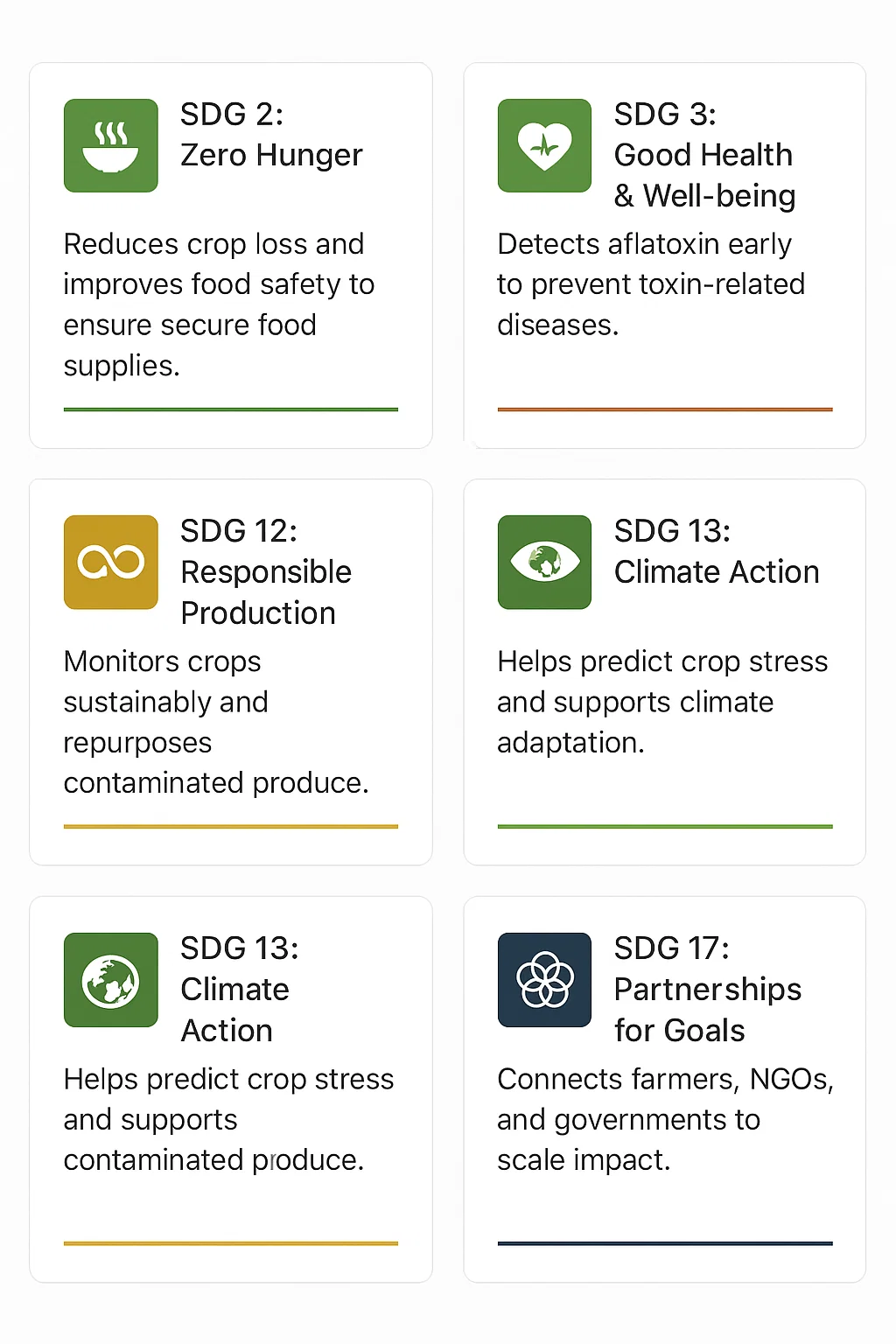
Acknowledgments
We, the Verdan team, would like to express our heartfelt gratitude to everyone who guided, encouraged, and supported us throughout this journey. We are deeply thankful to the Technical University of Denmark (DTU) for giving us the opportunity to work on a socially impactful project that bridges the gap between technology and real world problems. This experience has truly expanded our perspective.
Our sincere thanks go to our mentors and guides, whose tireless support, sharp insights, and thoughtful feedback were helpful at every step. Your encouragement helped us innovate our thinking, stay grounded in impact, and push boundaries when needed.
A special thanks to our partner organisations and domain experts who offered valuable inputs on the aspects of scoping, ideation and execution. Your field insights helped us align our solution with community needs.
And if you made this far, thank you!!!
Conclusion
In conclusion, our platform Verdan represents more than a technological innovation. It is a step towards safer, smarter and more inclusive farming techniques. We have used AI, IoT and community driven design that addresses real challenges faced by farmers, government, agencies and consumers. These learning sessions not only strengthened our technical background but also made our deep understanding of how technology can be used for social good. As we look ahead, we are excited about the potential to scale this solution, expand its reach to new regions and continue building tools that empower communities to ensure food security.
References
- Probst, C., et al. (2007). “Outbreak of an Acute Aflatoxicosis in Kenya in 2004.” Applied and Environmental Microbiology, 73(8), 2762-2764.
- Azziz-Baumgartner, E., et al. (2005). “Case-control study of an acute aflatoxicosis outbreak, Kenya, 2004.” Environmental Health Perspectives, 113(12), 1779-1783.
- Meijer, N., et al. (2021). “The aflatoxin situation in Africa: Systematic literature review.” Comprehensive Reviews in Food Science and Food Safety, 20(1), 117-158.
- Partnership for Aflatoxin Control in Africa (PACA). (2015). “Aflatoxin Impacts and Potential Solutions in Agriculture, Trade, and Health.”
- IARC Working Group on the Evaluation of Carcinogenic Risks to Humans. (2002). “Some traditional herbal medicines, some mycotoxins, naphthalene and styrene.” IARC Monographs, Volume 82.
- Pearson, T.C., et al. (2001). “Detecting aflatoxin in single corn kernels by transmittance and reflectance spectroscopy.” Transactions of the ASAE, 44(5), 1247-1254.
- Njeru, N.K., et al. (2019). “Influence of socio‐economic and agronomic factors on aflatoxin and fumonisin contamination of maize in western Kenya.” Food Control, 98, 280-290.
- Wang, Y., et al. (2022). “Effect of environmental factors on the aflatoxin production by Aspergillus flavus in maize kernels.” LWT – Food Science and Technology, 154, 112703.
- Wu, F., et al. (2010). “Public health impacts of foodborne mycotoxins.” Annual Review of Food Science and Technology, 1, 435-461.
Team BlueVerse-YA-IN-1
Contact us – https://linktr.ee/verdan.india
Team Lead:Aryan Karmore
Email ID:[email protected]
Aditya Pravin Bhalerao
Email ID:[email protected]
Raveena Vilas Basarimarad
Email ID:[email protected]
